It is three years since my dear friend Miguel Tavora died after a courageous battle with cancer. Right to the end he maintained the dignity, the humour and the warmth that marked my long association with him. I will publish this series of five articles that first appeared some ten years ago, in a tribute to his memory and to remind us all how much we lost when he left us. Scarcely a day goes by when I don’t think, I’d like to talk about that with Miguel…
We are lucky, not long before he died, Miguel finished his book, published first in Portuguese, then in English. His insights will live for as long as there are horsemen and women who realise that reading can be the key to riding. CH
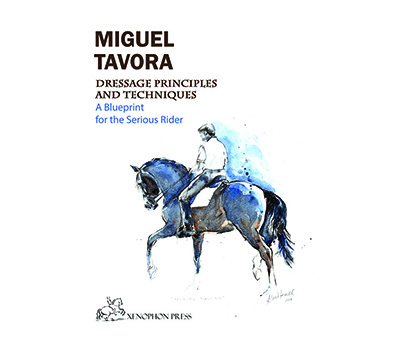
The book is available from the publisher, Xenophon Press
Miguel Tavora is a Thinking Horseman, a curiously old fashioned appellation for what, one suspects, is a heavily endangered species. Miguel doesn’t routinely mouth platitudes about the Great Masters of Dressage – he actually reads, and re-reads, them… in English and, if necessary, in French. Not forgetting his study of the equestrian works of his countrymen in Portuguese, or the writings of their near neighbours, the Spanish.
Does it affect his teaching and training? Yes, that learning provides a vastly richer variety of responses, exercises and solutions. I remember the best thing about training with Miguel was the way you went away from even a single 45-minute session, with a whole new bag of exercises and figures to ride. Not sure the half-halts are getting through? Try riding a trot shoulder-in along the long side, make a walk transition without losing the position of the shoulder-in? Find that too easy? Try renvers in left canter (on the right rein) along the wall, leave the wall on a diagonal and start the pirouette to the left. During this pirouette make a transition to the walk keeping the horse on the same pirouette.
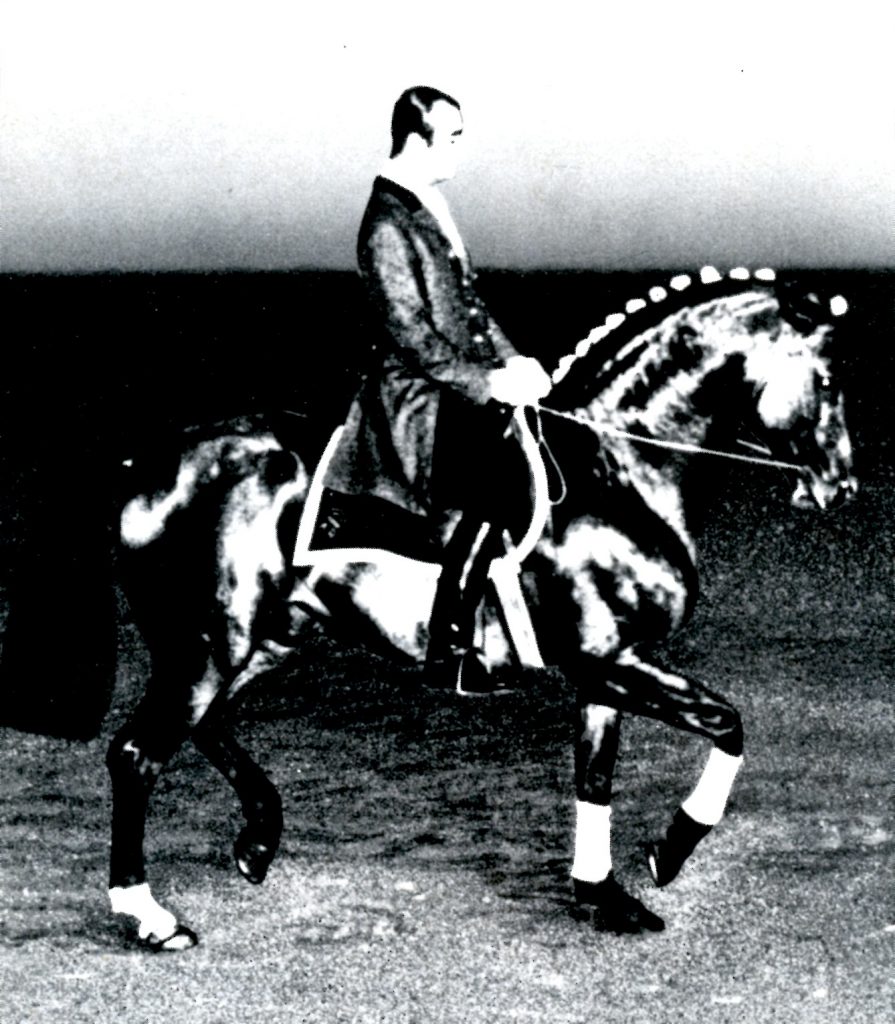
I think Miguel was both blessed and cursed through his association with the great Portuguese écuyer, Nuno Oliveira. Poor Nuno, especially after his death in a Western Australian motel in 1989, became the champion of that group of riders who are too sensitive and artistic to ride at competitions, who spend their time mincing around the school at home, usually tricked up in a double bridle with the poor horse hollow in the back and flicking its legs. “Wow look at the Passage!” Pissage more like.
It was a travesty of Nuno’s life and work – he was a trainer who prided himself on producing horses athletic enough to get out of the way of the horns of a charging bull – and while he is enlisted in an obsessive lovely light French versus heavy hard German fantasy, this ignores the fact, that the first and foremost text at Nuno’s side was the founding text of the modern German School, Gymnasium of the Horse by Gustav Steinbrecht.
When he arrived in Australia in 1982 Miguel got lumped in the too superior to compete army, although he soon set about confounding those expectations. At a time when none of the Australian horses could passage (we are talking early 80’s here!) he produced Wendy Johnston and the Thoroughbred stallion Runs on Love, and for the first time Aussies could see what a passage should look like.
To hammer home the point, in the 1990’s he produced Australian Grand Prix Champions, Dawn Mitchell and Ballykisteen Sedaka (and yes, like ROL, another Thoroughbred), followed by another classy Grand Prix Thoroughbred for Dawn, Exposay.
George Morris and Miguel share their philosophies on training and teaching on one of Miguel’s visits to the US
Of late, Miguel has been finding a ready audience for his teaching in the United States, and has spent much of his teaching time there, but now, with a new property at Kurmond, he is looking to spend more time in Australia.
He is shocked when I confess that I have stopped riding, saying that to stop riding would be for him, like stopping living – his obsession with the horse has been lifelong…
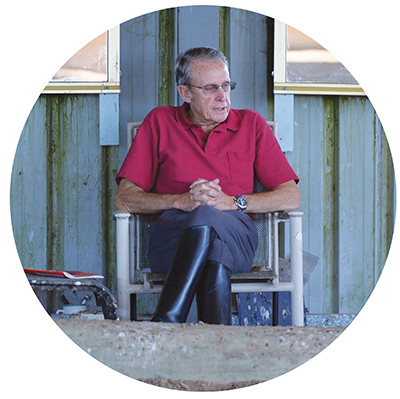
Major D. Miguel de Lancastre e Tavora (Abrantes) 1943 – 2017
“When I was a child on the right hand side of our house where I was born, there was a stable and a man had a horse and a cart to carry furniture around the town of Lisbon. That was the first horse I saw, and since then, I thought horses were what I wanted to do…”
“My father and my father’s family were old fashioned, so of course they had horses. My grandfather was in love with carriages and driving, and he spent a lot of money buying Lipizzaners to pull the carriage – this was in the nineteenth century. My father was not really a horseman, even though he fought in the first world war in the Belgian Cavalry, but he was never a very enthusiastic or good rider.”
“One of my uncles Rodrigo de Castro Pereira was one of the first top showjumpers in all the world, at the end of the nineteenth century, beginning of the twentieth. He was the one who started Nuno Oliveira – Nuno used to work on his arena, he was one of the first to promote Nuno Oliveira. He took me to Nuno to ride when I was eight years old.”
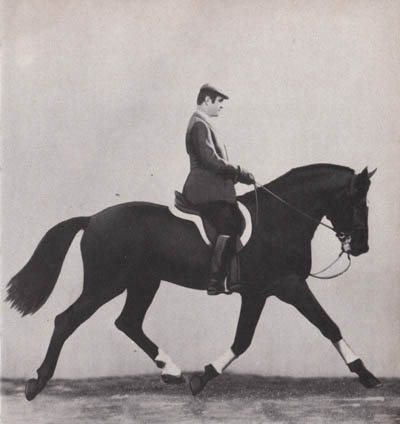
“I rode with Nuno Oliveira for ten years, until I went to the Military Academy when I was eighteen. In the Army I did much more eventing and showjumping – and we were at war in Africa so I didn’t have very much time. After the war I went to the School in Maffra, which is a military riding academy, like Saumur in France, in fact it was established by officers from Saumur. Colonel Saint Andre who was very famous in France, came to Portugal and lived there a long time, and he formed the school in Maffra – which trained not only military but also civilian riders.”
“It was a very good experience because having the basic classical training of Nuno Oliveira and the demanding competitive training in Maffra, helped my career. I competed a lot in showjumping and eventing. I competed a lot in dressage too. I learnt that the classical academic principles should be followed absolutely correctly, in the right time, in the right place, and they are not just a fantasy, they are real.”
“In the competition, you can’t say, ‘oh he’s not right today, I’ll do it tomorrow’. You’ve got to be able to produce at that moment – and that gave me a discipline that with Nuno we never really had. Nuno was more of an artist, a perfectionist but not oriented to competitive riding. To him riding was just an art, and sometimes it was lacking not the discipline of training but the discipline of actually putting together a competitive dressage test.”
story continues below the advertisement
“In Maffra, I learnt that from very good instructors in showjumping and eventing. I ended up staying at Maffra as an instructor, and became the Écuyer en Chef, just before I retired. And through that period I was always in contact with Nuno Oliveira, he was my advisor and friend.”
“If I had a problem with a horse I would go to him and ask for his help. He helped me a lot. He started his career training horses to compete, mostly he trained showjumpers – he would train the flatwork to prepare them to jump. He even competed in showjumping when he was young.”
“I decided to retire, I asked Nuno Oliveira to find me a place and he found me a place here in Australia.”
Miguel likes to start his horses himself, but he has reached that stage in life, where he prefers to let his neighbour, Matthew Bates actually sit the first few rides – but it should be noted, the horse has been well taught with the lunge line before that…
“Rather than talking about breaking in, I would rather talk about familiarisation, or first stages of training. I assume that the horse has been well handled already, that’s very important, and well handled just means well handled, not confusing the horse by playing with him like a dog, and with too many treats – just teach the horse to go from A to B, to be lead from one side to the other, to pick up the feet.”
“When he comes to the arena the first task is to teach him to lunge. It is on the lunge that he starts working on balance and impulsion – similar to the work he is going to have when he is ridden. He must start to develop his muscles and supple up his joints and his body, to prepare him to be ridden. This is the physical basis of the work on the lunge. At the same time, on the mental level, we are starting to teach some communication skills – whip to go forward, the lunge line to slow down and make the circle smaller or bigger, to begin to having some control, starting to develop the language of the aids.”
story continues below the advertisement
“We start to establish that language of the aids by making use of the principle of association, so that when I put the rider on the horse’s back later on, he associates what he knows on the lunge with the aids that the rider gives when he is on the horse. He begins little by little going not from my aids, but from the aids of the rider. If he doesn’t go for the rider, I go again with my aids from the ground.”
“Most important of all is the gymnastic point of view because by working on that outline, the balance that he uses must be different from the balance he uses when he is out by himself in the paddock. With the rider on his back he needs to engage the hindquarters, needs to flex his poll, he needs to come round, and like that he goes in a way that is balanced.”
“With the work on the lunge, the horse starts always with a good movement forward, he starts developing the muscles to be comfortable to be going in this way later on when he is ridden.”
“Then comes the rider – and at first this is very difficult work for the rider. He has to be very well balanced, be able to accompany all the movements of the horse, because what I want him to do at this stage is just connect himself with the movement and do nothing – in order that the horse can get used to that strange weight on his back, and find how to organise his body to go under that weight. We are still lunging him with the side reins very long, just to keep the horse in the correct outline.”
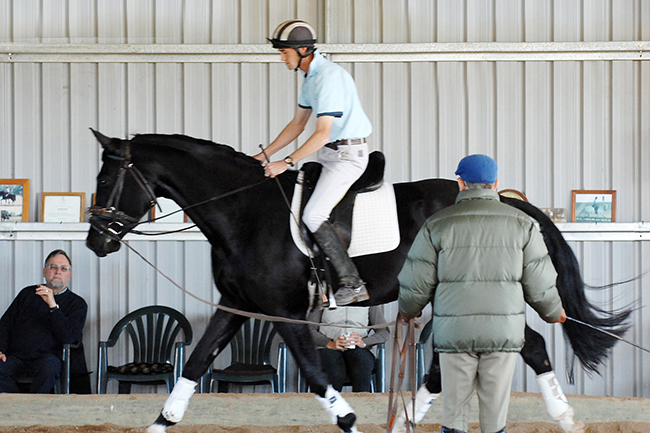
“In the first phase, Matt, my helper, just stays on the horse very quiet, and he doesn’t do anything. He knows that I will control the horse, and stop the horse if it tries to do something stupid. Of course if the horse gets out of my control, then Matt will help himself for sure.”
Just a week or two before we visited, something startled Felix (by Falsterbo) – and before he knew it, Miguel was on the floor of the arena. Matt rushed to his side. “Are you alright?” “I am, only my pride is hurt.” That afternoon, Matt was riding yet another youngster, and he too hit the deck. “Are you okay”, “Yes, I am, but my pride is with yours…”
“The second phase we start with the association process. I say, ‘Matt push’, and he touches with the legs, and at the same time, I push with the whip. The horse knows the whip, but he didn’t know the legs – but because he knows the whip, he learns legs and whip. And I do that many times until I say, ‘Matt push’, and the horse goes from the legs without waiting for the whip.”
But it is from very light leg that he responds?
“Exactly, and if any time the horse doesn’t respond to the legs, I don’t increase the strength of the legs – I use the whip again. I reinforce, I go back to the basics, because if the horse doesn’t go from the light leg, then he doesn’t understand. Little by little, the horse will go from the legs and not from the whip. In this time it is very difficult because the rider can’t touch on the bridle, he must not touch on the mouth. The horse must go forward and I say ‘whoa’ and go forward, push again, just teaching the legs.”
“Then when I say, “Matt walk’ or ‘Slow down the trot a bit’ and Matt sits a bit and takes and gives without legs, at the same time I go ‘whoa, whoa, whoa’, and with the lunge line I make the horse slow down, and he comes to a shorter trot or a walk or whatever. The horse starts to associate Matt’s hands with my aids, and very soon I don’t need to use my aids, and the horse is listening to the rider. Again, any time the horse doesn’t respond, Matt is not going to start pulling on the reins – it is always take and give, and if the horse doesn’t respond, then I provide the reinforcement from the ground.”
“The next step is to make the circle smaller, and I say, Matt open the inside rein, and as he opens the inside rein, I shorten the lunge – and he begins associating inside rein and opening rein – and he knows the lunge, he starts to understand, open the inside rein means make the circle smaller.”
“I walk in front of the horse, and say, ‘Matt open the left hand rein’ and the horse goes to the left, open the right and the horse goes to the right. It starts with the horse going from the cavesson and the lunge, but eventually he goes not from me, now he knows legs, he knows hands, it is time for Matt to ride him and for him to go free.”
“I still stay on the ground, and normally I have another helper down the other end of the arena, the horse is still working on the circle, I still help him from the ground with the whip. He still remembers the lunge, and he is very controllable – then he starts going more from Matt. Little by little I withdraw, and Matt takes more control. Any time the horse doesn’t respond, if he doesn’t respond to the legs, then Matt doesn’t increase the legs, I go with the whip, so the horse stays light to the legs.”
story continues below the advertisement
“The second part is to teach the horse to go from the rider’s whip – and Matt starts carrying the whip, he touches with the whip, I reinforce with my whip. After he associates Matt’s whip with my whip, then he goes from Matt’s whip.”
“Next with the spurs. Matt asks with the spurs, I ask with my whip on the ground, because sometimes with the spurs the horse will curl up instead of going forward. Spur and whip, spur and whip, then the horse knows it that the spur is to reinforce the leg, and to go forward. Everything is very simple. Circles, then go large, circle, go large…”
“At the same time I am starting a little bit of mobilisation in hand, turn around the inside leg – then the horse starts to learn to go from the inside leg, and that is what breaking in is. Everything is very simple, very confident, the horse knows the aids, knows the balance, he knows his ABC, and we start to ride the horse, he is ready to do the exercises that he needs to continue developing his body, making himself strong, and obedient.”
When do we start to take a contact?
“The horse already has contact with the side reins, and he accepts the side reins. Once he starts to go from the legs forward, and the rider starts opening the inside rein, the horse by himself is in contact, we don’t think about it – it happens, he is there. Without thinking he passes from the side reins to the reins, and when I say ‘Matt, slow down the trot’, Matt takes and gives, takes and gives, and with my cavesson and lunge I slow the horse down. The horse begins to accept that hands are to slow down, to take contact, and little by little without Matt having to think about it, the horse accepts the contact by himself.”
When do we switch from the horse accepting the opening rein, to the horse accepting the outside rein?
“That is much later on. When I start working with a bit of the shoulder-in on the circle, we ride the shoulder fore, and then the outside rein happens. If I keep my outside rein, and very quietly open the inside rein so the horse bends, then he accepts the contact. It happens, I never tell him go to the outside rein. Open the rein, make the circle smaller, bend him a bit more, the horse bends a bit more, stretch, and he begins to accept the outside rein. Never go to the outside rein, because if he goes to the outside rein, he shortens up and jams the neck.”
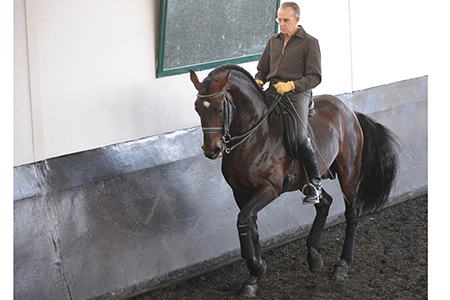
“Aids are the way we communicate with our horse. They are not instinctive, they have to be taught to the horse. We start in the first phase of the training on the lunge, and after we sophisticate and combine the aids. The most important thing of all is that I have two basic aids: my legs and my hands. My seat and my back are going to make my legs and my hands more effective. What my seat does is make my legs act on the right time and the right place. My back helps my hands work at the right time, in the right place.”
“In the past, they used to call these ‘weight aids’, that by putting the weight to one side or the other, the rider would help the horse. I don’t think that is quite true. What is very important, for example, in a half pass to the right, is not for me to put my weight on the inside stirrup, because if I put more weight on the inside, I am going to make the horse unbalanced. What is more important is not to let myself put the weight on the outside stirrup.”
“Sometimes when we say put the weight on the inside, it is not really to put the weight on the inside, it is NOT to put the weight to the outside. The rider has to try to be in the middle of the horse. Of course you might have a horse that is resisting going to the right in half pass – then I might lean a bit more to the right, and help the horse to go more to the right. But on the other hand the horse can then start running to the right, rushing to the right, because he loses the balance because of my body. Better to ask, why is the horse not going to the right? Because it is not bent, not engaged? Solve that problem and try to keep your weight in the middle instead of finding a trick and putting the weight more on the inside.”
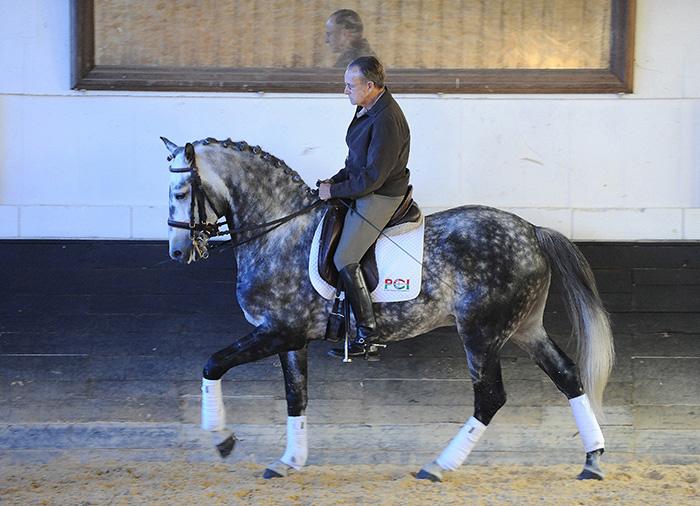
“Right from the beginning of the training we have to teach the horse to go by himself. He has to learn to go in self-carriage. I tell him to do something, and the horse starts doing what I asked, and I stop telling him what to do. It’s like teaching the horse to bend to the right, if I ask him to bend to the right, and he does it, and I keep asking him to bend to the right, then he doesn’t understand – then he becomes numb or he starts resisting to get away from the aids. The aids have to cease when they are obeyed. That is the most important principle of all – we don’t support the horse.”
“When I am riding this three-year-old horse, I am mixing rising and sitting trot but I stay very light in the saddle. I occasionally ask my wife, Di, to push with the long whip from the ground. At this stage, I am still working legs without hands, hands without legs. First he has to understand this, then we put it together. I don’t give a damn about having him round at this stage, just going forward because I know that when he goes forward and responds to my legs I can immediately make him round by the bend [on the circle], by transitions and ultimately by the half halt. If he is not responding to my legs, then Di comes with the whip, and I will end up with a horse that is light to my legs, light to my hands.”
“Now I can ask a little shoulder-in on the circle. This is the first and last lesson of de la Guérinière. With a young horse like this in the first year of his riding, this is serious, we are not playing, it is very serious, but we are considerate, he is a young horse, he is immature – he’s ours, so we don’t need to hurry.”
“Now I am concentrating on transitions with him. He is sensitive but not stupid. Usually with a horse this age, they are clumsy, losing balance, drifting in and out in the canter – he has never had this problem. He has always been balanced and strong on his feet. He can stretch down with good movement and he is never on his forehand – but if he curls back, then I need to do something to correct it.”
“The first balance we are working is horizontal (round and more, or less, down). When he flexes the poll, the nuchal ligament stretches and I can make him engage the hind legs. Sometimes I have to ride the horse right down. I will put him in whatever position I need to feel his back come up. The back is the bridge and connection between the forehand and the hindquarters, this bridge must be strong and supple in order to always have a good connection. It is through this connection that my horse will be able to respond to my half halt and become durchlassigkeit, which is the quality in the horse that permits the aids to pass through his body and achieve lightness – which is the horse obeying to the slightest aid of the rider.
Click this link for Part Two with Miguel Tavora
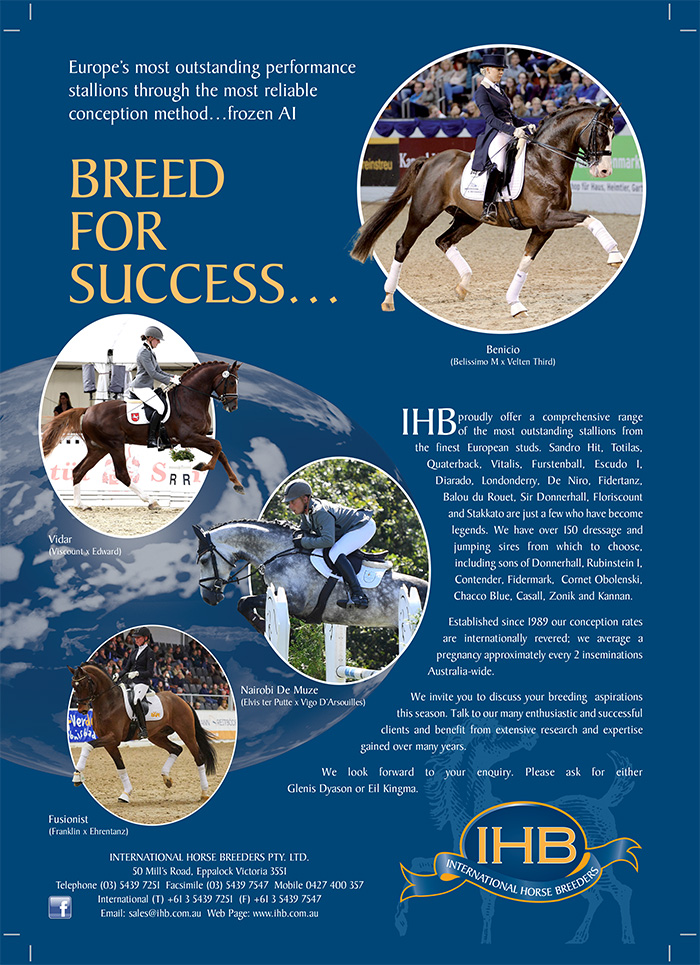



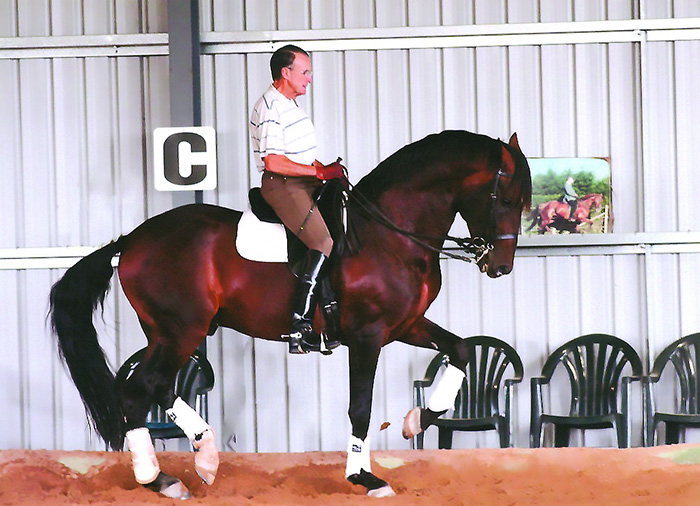
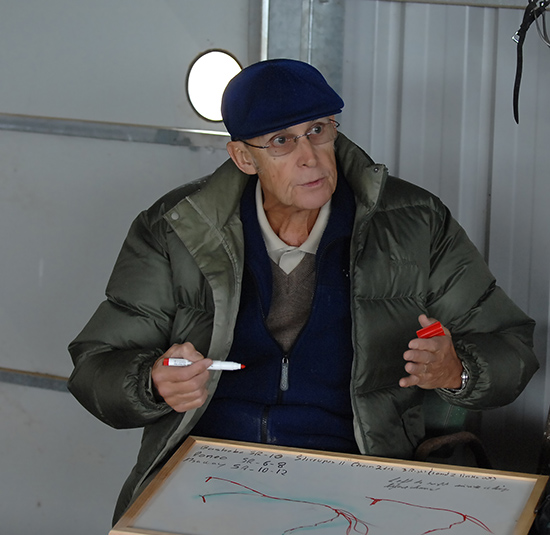
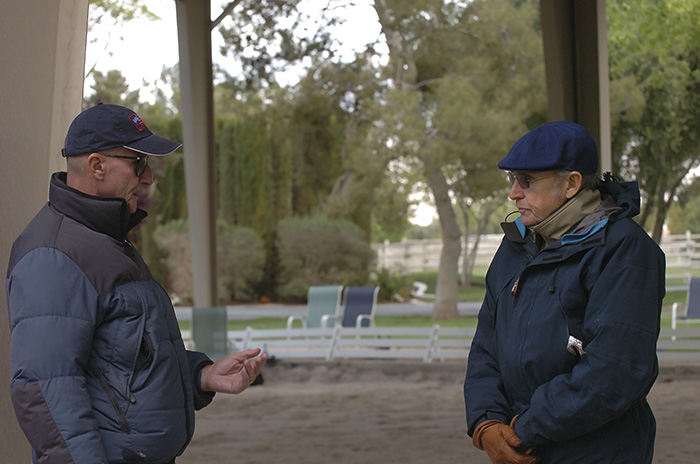
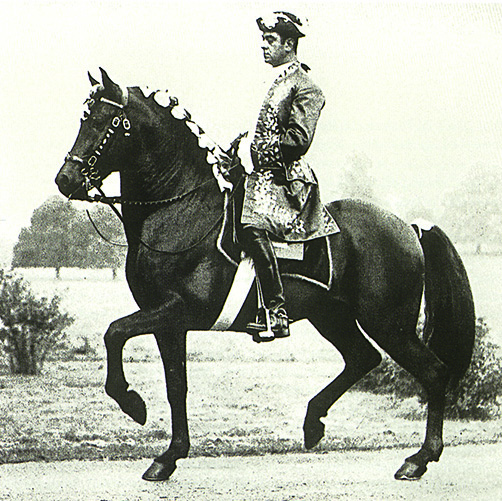
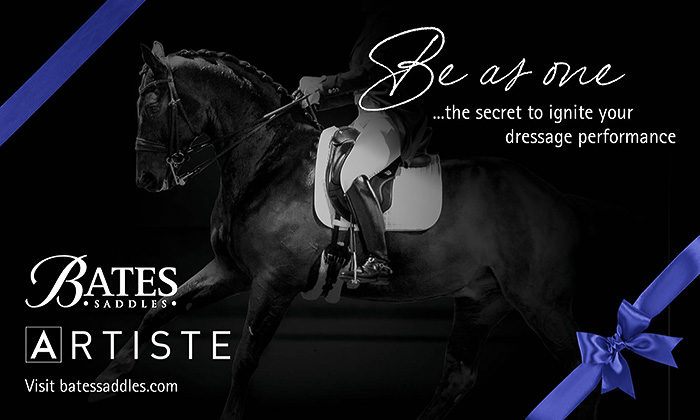
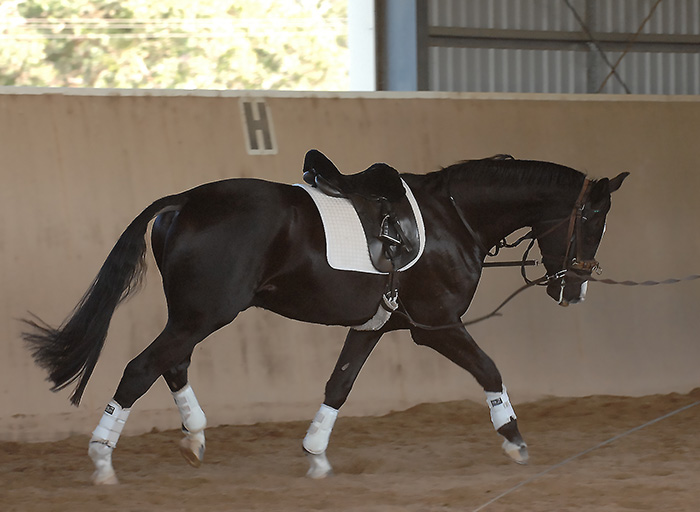
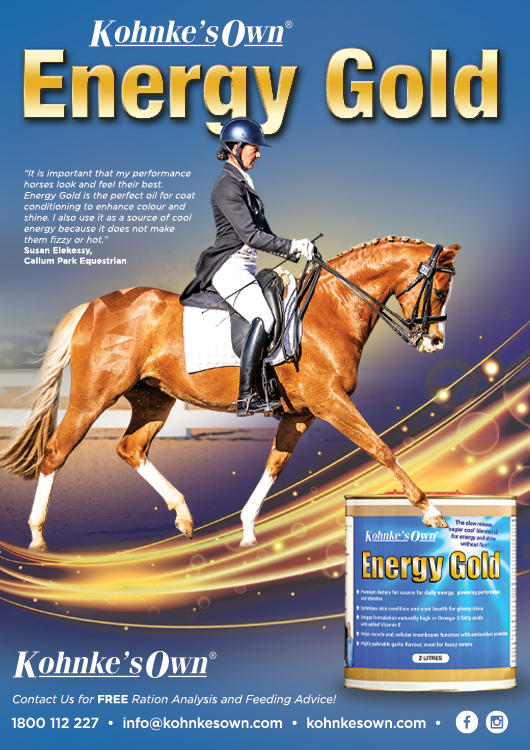
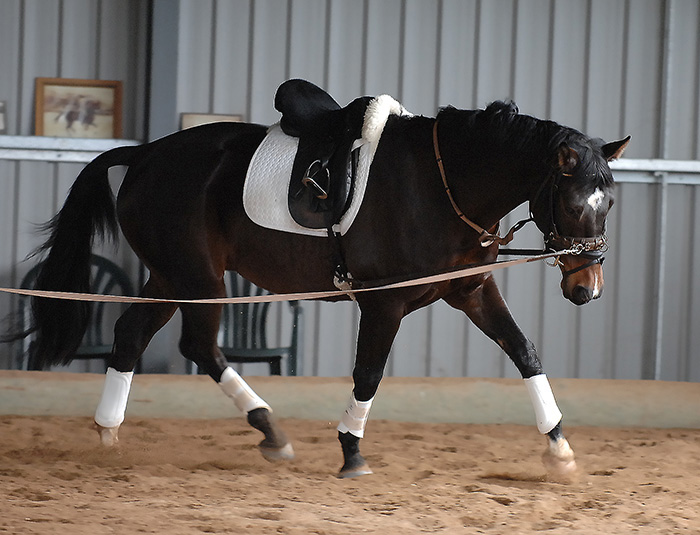
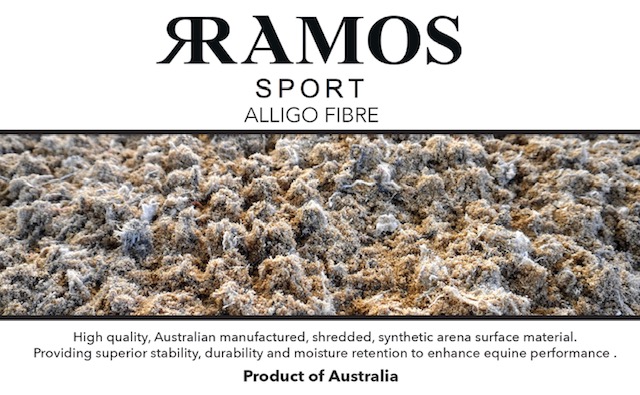
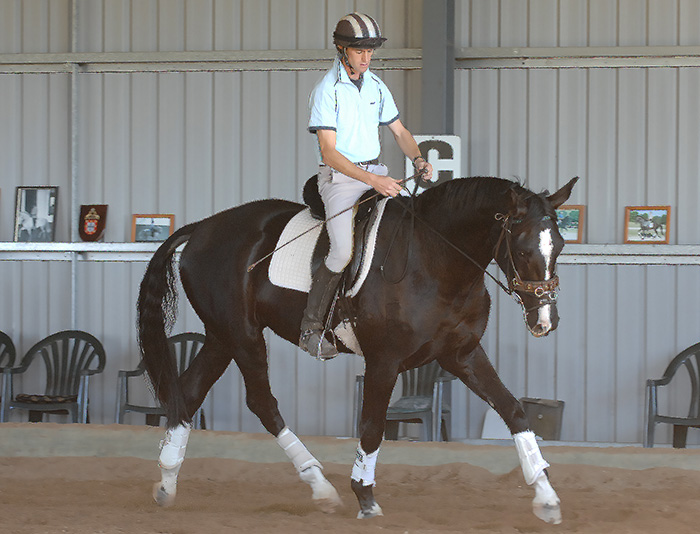
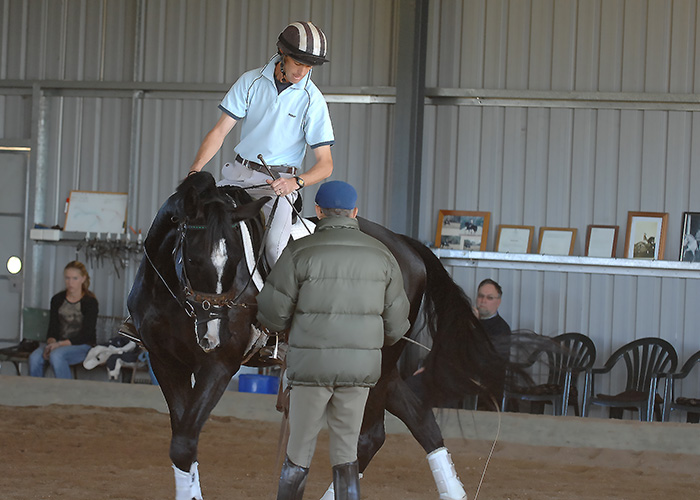
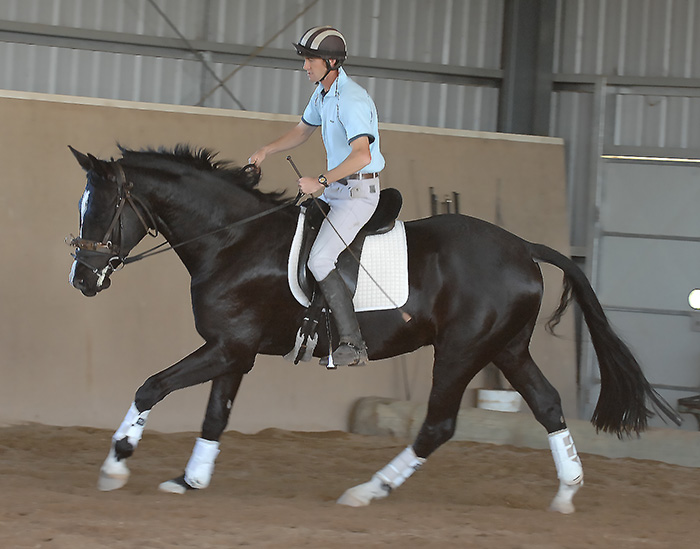
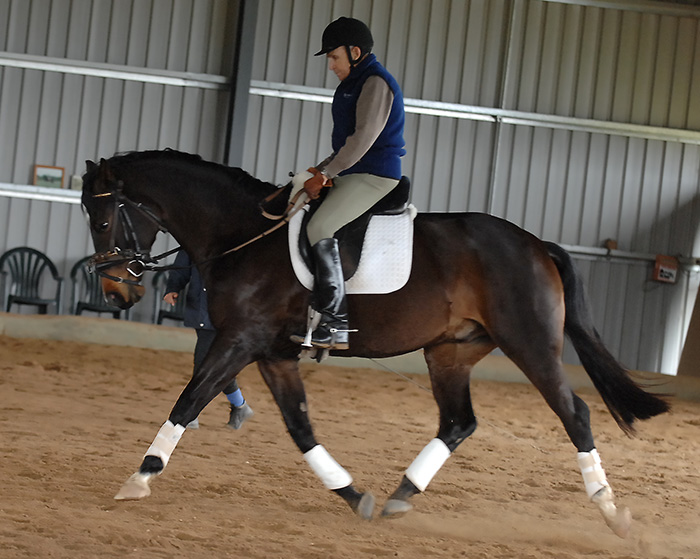
I always thought of this great man as the fulfillment of Nuno’s potential. Tavora brought every bit the artistry, but without the nonsense, the cultish personality, the horde of weirdos trailing behind him and without the fear of being judged in open competition. Loved the article and the photos, what a loss that he is no longer with us.
Oliveira did not always choose his students wisely (or his horses for that matters, as he could have sometimes bought better horses that would have demonstrated his technique more convincingly). That said, there is a whole group of professionals that studied with him and applied his principles and advice in competition, in the professional training of horses for various important stud farms, and in the bullring where the truth suffers no BS. They had a respectful professional relationship with him without indulging in the cult of personality that he induced in his lesser proficient but adoring followers.
Some of his original students, besides Miguel Tavora (Graciosa father, Borba, Athayde, Henriquet and others) have formed students who had an impact on international competition. Hildegard Gekiere for instance studied with Athayde at the National Stud of Alter at the same time I did, and was the teacher of Anky van Grunsven in Belgium. My great friend Francisco Cancella d’Abreu, discoverer of Baloubet du Rouet and Novlheiro, has been an international coach for decades, a FEI 3 star judge and a successful dressage competitor. He was a long-time student of Dr Borba who tried for the 1960 Olympics and was the founding professor of the School of Jerez as well as the founding director of the Lisbon School. Both Schools produced many international competitive riders and Oliveira was their “Equestrian Grandfather”.
After one year with Oliveira in Portugal and 4 years with Dom Jose Athayde in Alter, I spent a very long career training international competition horses in Spain, France, England, the US and Canada, (even briefly helping one of your better Australian riders), some winning championships in eventing (European Champion Mystic Minstrel – 4 gold, and Gurgle the Greek – 1 silver with Rachel Bayliss) and showjumping (the international GP winner Lusitano stallion Novilheiro, leading money earner with John Whitaker) as well as dressage riders (Delia Cunningham, Rachel Bayliss, etc.). Two months ago, my homebred horses JP Orion ad JP Zorro, 2 full brothers Iberian horses won Champion and Reserve at I2, GP and Freestyle at the US Regionals (the only real competition we have had this year) with my student/assistant of over 10 years, Cedar Potts.
The purpose of these comments is not for the dubious enjoyment of personal bragging, but to bring to the fore the point that Oliveira’s work is defined by timeless principles and the unquestionable demonstration of their validity through countless trained horses, not by the breed of horses he mostly trained, not by the tiny size of his arena that limited their gaits, nor the limited quality of his more amateurish followers who preferred to daydream about magic than actually do the hard stuff in a dressage court.
I certainly agree with you that Oliveira, who started his career under the influence of Fillis (through his own teacher Miranda), understood that a complete vision of dressage had to include Steinbrecht, Baucher, La Gueriniere, Marialva (the dressage foundation for bullfighting tradition) and created his own unique blend of the all the aforementioned. Having started young horses under his direct supervision, I can assure you that the methodology was very German in essence! Though I have no direct interest in reproducing his work exactly (different times, different horses’ gaits, different arenas of demonstration), I cannot think of a day in which I do not recall his advice to solve practical problems. This is why I spent some time translating his book “The Wisdom of Nuno Oliveira” from the French to English for Xenophon Press, who also published Tavora’s work. I still think that it is prescribed reading for all, along with Decarpentry, Raabe, Steinbrecht, etc.
As public trainers, we all have had clients with genuine interest but limited ability and ambition and we cannot be judged, as teachers, by their lack of competitive results, but rather by the dedication we have applied to their education and by the efforts we inspired them to make for the sake of their horses’ wellbeing. After 36 years teaching in the USA, I have actually learned more from my amateur clients than from my Olympic level European students (who already knew how to ride before they came to me), but I have little to show publicly for that work other than my personal satisfaction and a catalog of ideas full of solutions for the very complicated problems presented by uneducated riders attempting to manage the training of uneducated horses. That said, those amateurs buy horses, saddles, books and breeches, take lessons, read blogs, watch videos … and subscribe to thought-provoking magazines.
Respectfully submitted, JP Giacomini.
In the comments of the on very important Tavora article on Baucher and Steinbrecht, somebody asks the following questions, to which I am answering here to the best of my knowledge (both literary and practical), as comments were close on that article:
1.What is Ramener Outre,
It is the practice of an extreme flexion of the neck, poll and jaw, associated with very specific conditions (contact, position) and exercises (reinback then transitions to walk, trot and canter departs, piaffer and extensions).
2. How is it done, (the aids used to achieve it)
The best way to obtain the Ramene Outre in my experience is to first practice 2 separate diagonal effects in order to obtain 2 symmetrical lateral flexions of all the parts from the withers forward. According to Charles Raabe (best disciple of Baucher’s First Manner and best High School training system according to Decarpentry who re-edited his book with annotations in 1956), the diagonal effect is obtained by a pressure of the outside leg/spur as far forward and under the ribcage as possible (slight weight increase on the outside stirrup) to trigger a (practically automatic) flexion on the inside rein. The indisputable anatomical principle is simple: a proper flexion spreads the vertical apophysis of the dorsal vertebrae by tilting the withers to the outside of the bend and – as a consequence – tilting the sternum inward. When asked that way, horses are very willing to bend inward. Both lateral flexions (nose to the point of each shoulder) eventually result in a deep vertical, straight flexion. Vibrations on each rein (and vibrations of the spur) help the relaxation of the horse. He is then adopting the frequently used natural position of scratching his own shoulder.
3. Why is it done?
According to Faverot, the alternance of the Ramener Outre with the Elevation of the Head guarantees “a completely stable neck position” – read a steady contact and fixed poll (when required. Beudant also alternates it with a complete extension of the neck and head, a position recommended by Decarpentry.
This flexion spreads (decompress) the vertebrae, stretch the back muscles forward (longissimus dorsi) and the crest of the horse, brings the sternum up by the action of the 2 sterno-cephalic muscles, which lifts the withers and tilts them back. Lifting the withers and bringing them back oward the seat is a goal of all serious training systems. It is recommended to breeders of all sport breeds to select horses with high, muscled-up and prolonged withers, as an element for an uphill balance. 4. Associated conditions and exercises:
Faverot de Kerbrech, best disciple of Baucher’s Second Manner and his admirer Captain Beudant, considered by Decarpentry as the greatest trainer/rider he ever saw, insists that the position is only useful if the horse become completely light in the hand (arching his neck and not dropping its base downward).
The second requirement is to make sure the horse “always advances in his flexion”, so the protocol is to ask for reinback in the position (lengthen the brachio-cephalic muscles when the legs move back, the longer the step, the more effective the exercise), followed by departs, first into walk, then trot, canter and passage (shortening the same muscles that brings the elbows forward and guarantees impulsion). As a matter of fact, this arching of the neck associated with the high lift of the knees occurs at every single jump of a stylish horse over a big fence and nobody ever comments on it.
5. For how long should it be carried out (if at all)
The point of any training tool is to be used “as needed” and achieved progressively: never flexed so much that the horse cannot move forward (pushing against the bit), so the rider must flex the horse progressively and elevate the neck alternately – also progressively. The deep flexion counteracts the hollowing of the back, so it is occasionally useful to go back to it, just as we go to the full downward stretch. Flexions are another word for stretches, and there is nothing wrong with yoga as long as the positions attempted are not contrived and likely to produce injuries.
6.What is its relationship to Rollkur (if any) and how does it differ from Rollkur if indeed it does.
The great differences with Rollkur as I can see are as follow: the horse that is pull downed forcefully and never relieves himself by adopting a light contact will appear broken at the 3rd because the base (C6-C7) is dropped. The Rollkur horse fall on the forehand and lifts his croup (as seen on endless pictures), while a horse flexed deep in lightness can drop his croup and lift his back. Different equilibria, different back positions and functions, different contact, different exercises. The Ramene Outre achieves its purpose of lifting the base of the neck and stretching the back, so it contains its own obsolescence and his only needed very occasionally once the horse has been suppled up at one point in his training. Rollkur seems to be endlessly repeated as it does not really achieves its (un?)stated goal.
7. What is its relationship to and with the procedure of “l’Effet d’Ensemble.”?
The original Effet d’Ensemble was stated quite wrongly: opposing driving forces to a restricting force is designed for the automatic failure of one or the other action. The controlling effect of the technique is only valuable if the horse accepts the pressure of the bit by relaxing on it (flexing himself). The factor determining the gait of the halt is the actions of the seat: an immobile seat stops the horse, while hands and legs shapes his body. A moving seat determines the gait, while hands and legs shapes the horse and control his cadence. Unfortunately, Baucher – and authors of his time – never spoke much of the seat.
The sum of the 2 diagonal effects can be used as an “Effet d’Ensemble”. Raabe explains it as a way to dominate the horse in the halt, but also to simply settle the cadence of the horse by an ever-diminishing but steady pressure during a given gait. More important than the Effet d’Ensemble is the complete and progressive education of the horse to the various effects of the spurs (relaxing, animating, cadencing, controlling, stopping, etc.), but this is another subject….
JP Giacomini
Looking at the difference between a Dressage System, Training Method and Riding Technics.
Miguel Tavora, very astutely described the work of La Gueriniere as a “Method” and the work of Baucher as a “System”. A method can be copied, and we have adopted the codification of the dressage movements of the 17th century to this day. See definition of shoulder-in, half-passes, pirouettes, piaffer, passage, parade/arret, all Italian words transformed into the French and from there, to all other European languages. Methods are also specific to horse breeds and models of presentation: the pillars were necessary for preparing the airs above the ground and the piaffer was taught before the canter to horses that were heavy-built and found that gait difficult.
A well-conceived system will inspire many further developments that can be used with different training methods and affect positively the evolution of equestrian sports. Baucher laid the foundation of equine osteopathy (flexions) and neuroscience (vagus nerve trigger of the parasympathetic by the salivation and deglutition/swallowing associated with the flexion of the jaw); operant conditioning (the bases of the learning theory); the proper balance of equestrian sports (horizontal equilibrium that is indispensable to tempi changes, another of Baucher’s inventions), etc. many of his ideas remain entirely valid today and, as already stated by Tavora when quoting Decarpentry: “Everybody does Baucher without knowing it” … even if many concepts have evolved, such as the modern definition of the gaits, but lets remember that he worked in a circus ring of 13 meters in diameter.
To better understand the deep – and more exact – meaning of words, it is always useful to go back to their etymology – their root, which clarifies and differentiate their sense and importance.
During Elizabethan time, the word System entered the English language from the French, meaning “the whole creation, the universe,” rooted in the Late Latin systema ” – an arrangement,” and the Greek meaning as an “organized whole compounded of parts,” organized to form an order.
A method is an organized arrangement of technics. The word “method” entered English in the early 1,400s by way of the French (méthode). Its classical ancestors are the Latin methodus (mode of proceeding), and the earlier Greek methodos (pursuit). The pursuit of knowledge and its application in a disciplined manner should be the guiding spirit of the ever-learning horse trainer.
In the 17th Century, “technic” entered English from the Latin technicus, that came from the Greek tekhnikos, meaning the skills that form the art. A system is an ensemble of principles while method is about the order in which technical steps are achieved. Lets examine the practical sense of those definitions:
The riding technic is learned on a trained horse by repetition during the lesson. It is a tool designed to achieve a specific result (physical or mental) in the most effective way possible. For instance, there are many techniques to rebalance a horse, but they are all based on a physical (skilled) action of the rider (vertical or lateral actions, weight transfer) that can modify the horse’s biomechanics the right way. These actions must be learned and constantly refined to achieve the best results and form the Art of each rider.
The training tactic constitutes the lesson plan designed to teach the horse the new concept of the daily lesson. Practically, always teach the “smallest step possible” to facilitate each horse’s learning style (“Ask often, Be satisfied with little, Reward generously” – Baucher). For instance, it is a good idea to start the teaching of the counter-canter by a shallow loop and progressively increase the degree of the turn until it becomes possible to take the diagonal with a high probability of success in achieving counter-canter.
A “Training System” is a coordinated body of methods and techniques forming a complex but unified vision of the final dressage goal. It is guided by a constant set of principles, but its order may vary: the principle “Calm Forward and Straight” of L’Hotte (and Steinbrecht, more or less), is systematically valid for any horse in any discipline, but each component may be achieved in a different order according to the way each horse’s particular problem presents itself. Some horses need to be calmed before starting to work, others need to go forward before they calm down, others again will not go forward before they are balanced or straightened, etc..
The dressage strategy reflects the general planning the trainer needs to achieve his vision of the horse’s success. It is based on the trainer’s experience who can search for the best path forward in the sum of his/her memory according to the horse’s type, ability and temperament. After each lesson, the trainer must reflect on his lesson, maybe read an author competent on the particular subject or watch some relevant videos. For instance, a good strategy consists of principles such as: Always teaching forwardness first; lateral suppleness before collection; mechanics before expression; always diminish the aids as the lesson progresses in order to incite the horse to act eventually “as of his own accord”, etc.
The Equestrian tact is the permanent feedback loop that informs the rider of the horse’s reactions. As a result of the refinement of the sense of feel through constant observation of his/her tactile interactions with the horse, the rider can improve the “Goof Measure” (already stated by Grisone in the 1500s) of What to do? How Much? When? of his/her “perceptual aids”. Training technic, tactic and strategy can then be adapted to each horse to determine the best way to elicit the desired response in the moment and in the long term. In conclusion, we must learn the technics by endless repetition and observation, remain disciplined – yet flexible – in our tactic (respecting “The spirit of the Method” as General Durand wrote), and spend time analyzing and reflecting on our general strategy to remain inscribed in a dressage system that is pleasant to the rider, enjoyable by the spectator and, mostly, fair to the horse that we must keep sound and happy.